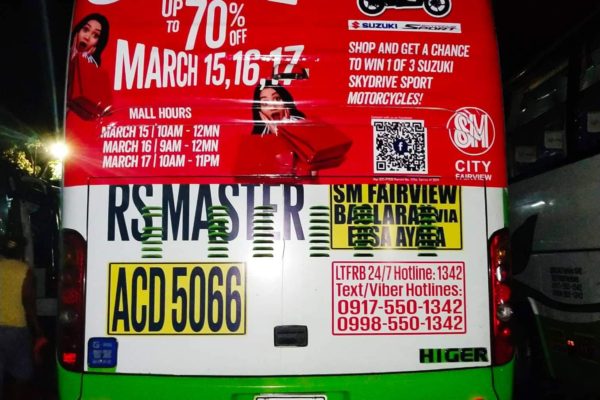Increase Your Company with Transit Advertising Philippines
Increase Your Company with Transit Advertising Philippines
Blog Article
Recognizing the Role of Transit Advertising And Marketing in Enhancing Brand Visibility and Customer Engagement
Transit advertising and marketing has actually emerged as an essential aspect in the advertising and marketing landscape, providing special opportunities for brands to raise their presence and engage customers effectively. With the capability to get to a captive and diverse target market throughout their day-to-day commutes, these advertising methods are not simply concerning exposure; they have to do with developing significant links with possible customers. As we check out the complex advantages and cutting-edge approaches within transit marketing, it ends up being necessary to think about exactly how these aspects collectively influence consumer assumption and actions, questioning concerning their lasting influence on brand name commitment.
Definition of Transportation Advertising And Marketing
Transportation marketing refers to the practice of promoting items, solutions, or brands through promotions positioned in and around public transportation systems. This form of advertising incorporates a range of placements, consisting of posters on trains and buses, digital screens at transit terminals, and wraps on the exterior of lorries. It aims to reach a varied audience, profiting from the high foot traffic related to public transit.
Transportation marketing is strategically placed to catch the interest of commuters, who usually invest significant time taking a trip or waiting. By integrating promotions into the everyday regimens of individuals, brand names can produce a lasting perception and foster brand recognition. The tool is especially effective in city environments, where public transport is a primary setting of traveling.
Furthermore, transit marketing can facilitate localized targeting, permitting companies to get to specific demographics based on transportation courses and station places. As city populations expand and using public transportation rises, this marketing approach has actually acquired importance as an essential component of incorporated advertising and marketing techniques. The vibrant nature of transportation advertising, combined with its capability to involve customers in a captive environment, highlights its value in modern advertising methods.
Benefits of Transportation Advertising And Marketing
The performance of transit marketing depends on its capacity to deliver a wide variety of advantages to brand names looking for to boost presence and involvement. Among the primary advantages is the extensive reach it provides; transit ads can successfully target diverse demographics across metropolitan areas, reaching both pedestrians and commuters alike. This broad exposure significantly boosts brand awareness.
An additional advantage is the high regularity of perceptions. As transportation cars follow recognized routes and stop at numerous areas, they produce repeated exposure that reinforces brand name messages. This regularity promotes familiarity, which is essential in consumer decision-making.
Transportation marketing is likewise affordable compared to various other media platforms. Given its large reach and possibility for high impacts, brands often experience a reduced expense per thousand impressions (CPM), optimizing their marketing budget.
Moreover, transportation ads can develop a feeling of community link. By lining up with local transportation systems, brands can reverberate with regional target markets and promote a sense of regional pride. This local method boosts brand loyalty and interaction, making transit advertising and marketing a compelling selection for companies intending to solidify their visibility in the marketplace.

Efficient Techniques for Transportation Campaigns
To maximize the effect of transit campaigns, brand names ought to utilize tactical preparation and execution customized to their target audience. Initially, determining the group attributes of the target market using public transportation is essential. This permits brands to develop customized messaging that reverberates with potential clients.
Next, choosing the ideal transportation tools is necessary. Whether making use of bus covers, metro posters, or digital screens, each tool has unique advantages that can improve presence. For instance, vivid visuals on bus covers can attract interest, while electronic advertisements can be upgraded regularly to reflect timely promotions.
Additionally, incorporating a natural branding strategy across transit platforms makes sure uniformity and reinforces the brand name's identification. Making use of attractive styles and unforgettable taglines will reinforce brand recall among commuters.
By using these methods, brands can effectively harness the possibility of transportation marketing, fostering greater recognition and link with their target audience. Ultimately, a well-executed transportation project can drive substantial development in brand name visibility and customer interaction.

Determining Impact and Involvement
In examining the effectiveness of transportation ad campaign, exact measurement of influence and interaction is important for brand names seeking to maximize their advertising strategies. Metrics such as reach, regularity, and impressions supply foundational information to evaluate presence. Evaluating these variables assists establish the number of prospective customers are exposed to the advertisements throughout their everyday commutes.
Interaction can be more determined through customer interactions, such as web site traffic, social networks states, and direct actions to calls-to-action featured in the ads. Making use of devices like QR codes or distinct Links can facilitate tracking of customer actions directly linked to transit projects. Studies and feedback systems likewise function as valuable techniques to collect qualitative information on customer perceptions and recall of the ad.
In addition, progressed analytics and attribution models can correlate transit direct exposure with succeeding purchasing behavior, providing insights right into the return on financial investment. By using a comprehensive method that integrates qualitative and measurable procedures, brands can develop a nuanced understanding of their transit advertising impact. Eventually, this data-driven technique makes it possible for brands to refine their campaigns, ensuring they resonate effectively with target audiences and enhance overall brand presence.
Study of Effective Projects
Effective transit ad campaign function as engaging instances of exactly how efficient techniques can elevate brand name presence and interaction. Transit Advertising Philippines. One significant situation is the "I Love New York" project, which changed the city's image and attracted numerous visitors. By using subway advertisements, signboards, and bus wraps, the campaign developed a strong, cohesive brand name identity, resulting in a other substantial uptick in tourist and local business patronage
An additional exemplary campaign is Coca-Cola's "Share a Coke" campaign, which leveraged transit advertising and marketing to customize the brand experience. By including prominent names on promotional products across numerous transportation platforms, Coca-Cola promoted a deeper psychological connection with customers, motivating them to share their experiences on social media sites.
Furthermore, the "Got Milk?" campaign successfully utilized public transport ads to get to a broad target market, reinforcing the message of the significance of milk in a balanced diet plan. The campaign saw a quantifiable rise in milk usage in target demographics.
These study show that when executed thoughtfully, transportation marketing can dramatically boost brand visibility, foster customer engagement, and drive quantifiable results, showing its important function in contemporary marketing approaches. - Transit Advertising Philippines
Final Thought
To conclude, transit advertising functions as an essential tool for enhancing brand name presence and cultivating consumer engagement. By making use of strategically put promotions basics within public transport systems, brand names can properly reinforce and get to diverse audiences recognition via regular direct exposure. The implementation of targeted messaging and cutting-edge approaches additionally enhances the impact of transit projects. Inevitably, the capability to gauge involvement and analyze successful situation research studies highlights the efficiency of transit advertising in driving brand name loyalty and consumer communications.
Transit advertising and marketing has actually arised as a pivotal component in the advertising landscape, supplying unique possibilities for brands to elevate their visibility and involve consumers successfully.Additionally, transportation marketing can facilitate local targeting, enabling organizations to get to particular demographics based on transportation routes and terminal locations.In reviewing the efficiency of transportation marketing projects, precise measurement of effect and interaction is important for brands seeking to enhance their marketing methods.Successful transit advertising and marketing projects serve as compelling examples of click this link how reliable methods can elevate brand name presence and engagement.In conclusion, transportation advertising offers as an essential tool for improving brand name presence and promoting consumer involvement.
Report this page